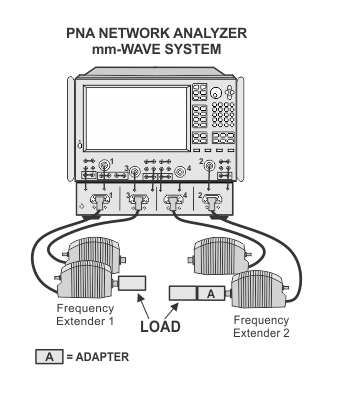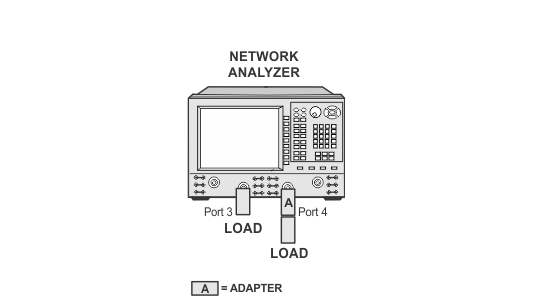
If an error message occurs on the PNA during this test, it may be necessary to run the IF Response Adjustment.
Refer to the Displayed Average Noise Level Troubleshooting topic for more information.
|
|
If an error message occurs on the PNA during this test, it may be necessary to run the IF Response Adjustment. Refer to the Displayed Average Noise Level Troubleshooting topic for more information. |
N5221B, N5222B, N5224B, N5225B, N5227B with Option 090 plus one of the spectrum analyzer frequency options (shown below) and <RSA> (see below for <RSA> explanation)
N5231B, N5232B, N5234B, N5235B, N5239B with Option 090 plus one of the spectrum analyzer frequency options (shown below) and <RSA> (see below for <RSA> explanation)
N5241B/BC, N5242B, N5244B, N5245B/BC, N5247B/BC, N5249B with Option 090 plus one of the spectrum analyzer frequency options (shown below) and <RSA> (see below for <RSA> explanation)
N5290A, N5291A mm-Wave systems with Option 090 plus one of the spectrum analyzer frequency options (shown below) and <RSA> (see below for <RSA> explanation)
The Displayed Average Noise Level (DANL) test measures the sensitivity of the receivers. It provides an indication of the minimum detectable signal when no signal is applied and the input is terminated by a 50 Ω load.
The actual DANL value is highly dependent on the instrument’s settings, and while the main dependency is on Resolution Bandwidth (RBW), other factors such as detector type, averaging type, Video Bandwidth (VBW), and number of sweep points can and will impact the DANL value as well.
The simplest way to understand the impact of RBW on DANL is to compare it with the impact of the IF Bandwidth on Noise Floor. That is, increasing/decreasing the RBW allows more/less noise power to be detected by the DUT. Although DANL is specified at an RBW of 1.2 Hz (lowest possible setting), it is measured with RBW set to 10 KHz, and to assure that the measured data complies with the specified RBW, a bandwidth correction is applied to the data.
For troubleshooting help, see Displayed Average Noise Level Troubleshooting.
N52xxB, N5290A, and N5291A models with Option 090 (spectrum analysis application) also require one of the following spectrum analyzer frequency options. TME will test to the maximum frequency of the DUT OR the spectrum analyzer frequency option range, whichever is lowest.
|
900 — up to 8.5 GHz |
|
901 — up to 13.5 GHz |
|
902 — up to 26.5 GHz |
|
904 — up to 43.5 GHz |
|
905 — up to 50 GHz |
|
907 — up to 67 GHz |
|
909 — up to 90 GHz |
|
093 — extend to 110 GHz |
|
094 — extends beyond 110 GHz |
This section will explain how to determine if your model requires Option <RSA> for this test.
Some models require Option <RSA> for this test. Options in angle brackets (such as <RSA>) are assigned by TME to facilitate testing and do not reflect product options. For this reason, Option <RSA> will not appear on reports or other places of the TME User Interface.
The following models require Option <RSA> to run this test:
N5221B, N5222B, N5224B, N5225B, N5227B
N5231B, N5232B, N5234B, N5235B, N5239B
N5241B/BC, N5242B, N5244B, N5245B/BC, N5247B/BC, N5249B
N5290A, N5291A
The following N524xA/AS models are assigned Option <RSA> by their serial number prefix break. Use the table below to determine if your N524xA/AS PNA-X model is assigned Option <RSA>.
|
Model Number |
Serial Number Prefix |
|
|
N5241A |
MY5201 and above |
Requires Option <RSA> |
|
N5242A |
MY5202 and above |
Requires Option <RSA> |
|
N5244A |
MY5204 and above |
Requires Option <RSA> |
|
N5245A |
MY5205 and above |
Requires Option <RSA> |
|
Test Equipment |
Recommended Model |
Alternate Model |
|
Load 3.5 mm 3.5 mm models 2 required |
85052B |
85052D |
|
Load 2.4 mm For 2.4 mm models 2 required |
85056A |
none |
|
Load 1.85 mm For 1.85 mm models 2 required |
85058B |
none |
|
Load 1 mm For 1 mm models 2 required |
85059B |
none |
|
Adapter, 1 mm (f) to 1 mm (f) For 1 mm models. Part of the 85059B cal kit. |
85059-60045 |
none |
|
|
Due to the complexity of the PNA family of analyzers, the following notes apply to illustrations in the PNA Help:
|
For default front and rear cabling between the PNA and the test set, refer to Step 2: Prepare the PNA for Testing of the Getting Started Guide.




